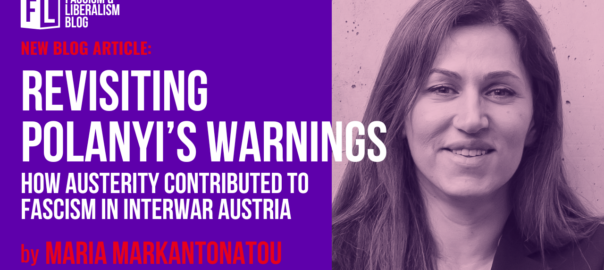Revisiting Polanyi’s warnings: How Austerity contributed to Fascism in Interwar Austria
by Maria Markantonatou
20.11.2025
The rise of authoritarianism in interwar Austria is often explained through economic collapse and social conflict. But could austerity measures themselves have played an independent role in destabilizing democracy? In this blog piece, Maria Markantonatou draws on Karl Polanyi’s writings to revisit the League of Nations’ “Financial Reconstruction of Austria,” a radical austerity program that imposed wage cuts, mass dismissals, and shrinking public services. As Polanyi argued at the time, liberal elites embraced “authoritarian interventionism” to protect the economic order, weakening democratic institutions and paving the way for Austrofascism. The dismantling of Red Vienna, the civil war of 1934, and the suppression of the Left were all intertwined with externally imposed austerity. The parallels with contemporary fiscal adjustment programs suggest that today, too, technocratic austerity threatens democratic resilience. The question now is whether governments will confront these risks or repeat the errors of the past.
Austria is once again entering a debate over austerity. Under the EU’s fiscal governance framework, the Austrian government is required to implement consolidation measures in the coming years, including reductions in public spending and welfare services. These measures are presented as technical necessities, but historical experiences show how austerity can fracture societies and fuel political extremism. A glance back at interwar Austria – where externally mandated austerity played a decisive role in democratic collapse – offers critical insights into the risks embedded in today’s fiscal debates.
In the first F&L blog article, Clara Mattei and Aditya Singh argued that Mussolini’s rise in interwar Italy was enabled by a liberal establishment convinced that “only an authoritarian state could defend the capital order in a country like Italy – where revolutionary energy among workers and peasants had reached a boiling point”. The authors conclude that the Italian 1920s demonstrate “the deep structural affinities between liberal and fascist economic policies.”
The 1920s “Financial Reconstruction of Austria”
A similar point can be made for interwar Austria. In 1922, the League of Nations (LoN), together with domestic liberal elites, launched the “Financial Reconstruction of Austria” program —the first peacetime experiment in technocratic international economic governance by a supranational actor. The program imposed harsh austerity measures, such as wage cuts and public sector retrenchments, which fueled deep political polarization and led to the rise of Austrofascism and civil war. Parallels with contemporary austerity programs show that, now as then, policies of imposed austerity undermine democratic institutions and empower authoritarian politics.
Polanyi, writing in Vienna for the financial journal Der Österreichische Volkswirt, observed these developments firsthand. He argued that the liberal attempt to insulate the economy from politics produced an “antagonism” between capitalism and democracy—one that culminated in fascism. Central to this antagonism was what Mattei and Singh describe as “the most Polanyian of all insights”: that free markets were never natural, but politically constructed. In the case of the LoN program, this construction assumed the form of what Polanyi called “authoritarian interventionism”, of which the stubborn support by economic liberals “had resulted in a decisive weakening of the democratic forces which might otherwise have averted the fascist catastrophe” (Polanyi 2001: 242).
The LoN program introduced sweeping austerity and liberalization, leading to unemployment, weakened social services, and political tensions. It began with a request to the LoN by the Austrian Christian-social Chancellor Ignaz Seipel, a Catholic priest. Seipel (in LoN 1922: 19–20) presented Austria’s situation before the LoN Council and asked for financial assistance to address hyperinflation, fiscal crisis, and insolvent banks. In his speech, Seipel appealed to the LoN describing Austrians as people “who have endured such terrible suffering and who are perhaps even more crushed by fear for the uncertainty of their future than by the physical misfortunes of the present time [and]are menaced by actual decimation through hunger and cold”. For Seipel (in LoN 1922: 20), the crisis was “unique in the financial history of the world”, as high exchange rates blocked imports of essential goods such as corn, sugar, and coal, causing shortages. The LoN offered loans but demanded the creation of a commission of experts to control their use. Seipel (in LoN, 1922: 22) accepted that such a control would be “inevitable and natural,” but only if “sufficient credits were granted at the same time.” Ultimately, the LoN assumed control of Austria’s budget.
From Budget Control to Monetary Chaos
Historians Stephen Gross and Chase Gummer (2014) describe how Austria, reduced from a Habsburg Empire of 50 million to a small republic of seven million, struggled with a disintegrating currency and chaotic monetary fragmentation. The successor states stamped the old Habsburg krone notes to separate their currencies from the imperial krone, but such measures quickly created monetary chaos. Economic liberals deemed it urgent to stabilize the currency, reduce capital flight and war-related deficits, and stimulate growth.
The LoN appointed a Commissioner-General to supervise the program known as the Genfer Sanierung. His team oversaw the budget and the reforms in banking and public administration, approved loan tranches, and reintroduced the gold standard. To receive loans, social services and the public sector had to be cut.
The LoN blamed the “excessive number of [state] employees” as the main cause of Austria’s crisis. This led to a reduction of Federal Ministries and the dismissal of 100,000 officials within two years. A similar argument was used to justify cuts in the highly unionized railway sector. The LoN blamed the City of Vienna too, for having more state employees than when she was the capital of an empire.
Ironically, the initial wave of dismissals raised public expenditure rather than lowering it, due to severance and pension obligations Covering these costs required another loan and, as a consequence, new austerity measures. Access to foreign capital markets re-opened, but the economy deteriorated again with the 1929-1930 global financial crisis. The collapse of the Creditanstalt bank in 1931 led to rapid capital flight and market panic, which necessitated another loan from external lenders, and further deepened Austria’s dependence on foreign debt assistance.
Notably, restriction of economic sovereignty did not imply a weak state. On the contrary, a strong state was considered necessary, as the LoN demanded the suppression of resisting social groups, trade unions, and political opponents, and the imposition of emergency legislation. The reforms required “a strong and fearless Government”, with the “duty not to hesitate to go forward with the necessary measures” , without “any political considerations” (LoN 1923: 10). Even after the assassination of Chancellor Dollfuss in 1934, loans continued to require further retrenchment, including new cuts to social services and pension rights.
Liberal Attacks on Red Vienna Paved the Way for Civil War
While Seipel negotiated the loan conditions with the LoN in Geneva, Red Vienna pursued a very different project: As the historian John Lewis recounts,“the Viennese authorities were developing a system of progressive taxation, which effectively shifted the bulk of the fiscal burden from the working classes (…) to the bourgeoisie”.
Red Vienna flourished in the 1920s, after the Social Democratic Workers’ Party’s victory in the 1919 local elections. Housing policies addressed poor working-class conditions: dwellings had typically consisted of a kitchen and a sleeping room, without gas and running water, while washing facilities were communal – conditions linked to tuberculosis and high mortality. From 1923 to 1927, the city council built over 25,000 small but modern units. These improved living standards but met resistance from landlords, who accused socialists of Steuersadismus (tax sadism) and of ruining the private housing market.
Conflicts between the Viennese authorities and the LoN’s supporters, who opposed the housing program, contributed to the Austrian civil war of 1934. This is why Polanyi (2001: 98) writes that Red Vienna “was bitterly attacked by economic liberals” and “succumbed under the attack of political forces powerfully sustained by the purely economic argument.” He criticized liberals who claimed that Vienna was merely an “‘allowance system’ which needed the iron broom of the classical economists”. When Red Vienna fell, “the Heimwehr victory in Austria formed part of a total catastrophe,” Polanyi notes regarding the civil war and the total crisis.
As social polarization deepened, Chancellor Dollfuss shut down Parliament in 1933. In 1934, a brief but devastating civil war erupted in Vienna, Linz, and Graz between state forces – supported by the paramilitary, rural-fascist Heimwehr – and the Social Democratic Party’s militia (Schutzbund). These events reflected efforts of domestic elites and the LoN to dismantle the Left and Red Vienna. As the British foreign correspondent Gedye (2009 [1939]: 12) put it, “the first thing was to get foreign money into the country, the second to persuade international finance (…) that its money would never be really safe until the power of the Left had been broken down.”
Polanyi agreed with this assessment that austerity was tied to anti-socialist politics: “[the Austrian government] never relaxed its pressure against the Left. The attack upon the position of the Left was carried several stages further. The Socialist press, the Social-Democratic Party, social services, rights of collective bargaining, the legal standing of public servants (…), the finance of the Municipality of Vienna, all had to suffer.” In his text, Austria and Germany, Polanyi follows the events after the 1933 German elections that paved the way to the Austrian Anschluss: pressure from Germany and Italy on Austria, the Austrian government’s Pronunciamento (banning public gatherings and imposing press censorship), far-right groups gaining power, and instability. The LoN’s interventions fueled polarization, empowered liberal economics, and repressed the labour resistance and socialist planning. While liberalism viewed markets as the only rational mechanism, Polanyi defended the socialist “overview” of production by communes, unions, and workers’ councils. In his seminal work The Great Transformation, Polanyi (2001: 265) argues that only their suppression paved the way for capitalist restoration and fascism:
“It was as a result of [the liberals’] efforts that big business was installed in several European countries and, incidentally, also various brands of fascism, as in Austria. Planning, regulation, and control (…), were then employed by the confessed enemies of freedom to abolish it altogether. Yet the victory of fascism was made practically unavoidable by the liberals’ obstruction of any reform involving planning”.
Interwar Austria as Forerunner to IMF and Eurozone-imposed Austerity
As the economic historian Charles Kindleberger (2006: 321) notes, “the LoN staff in Austria can be thought of as a forerunner of IMF stabilization advice to countries with balance-of-payments and stabilization problems after the World War II”. Following the war, the pattern of economic governance through “bailouts” was institutionalized: conditionality in the provision of loans to countries in need, with the poor paying the heavy price of austerity. The IMF intervened in a series of countries in Latin America (Argentina, Bolivia, Brazil, Chile, etc.), in Africa (Ghana, Morocco, Nigeria, etc.), in Asia (Bangladesh, Indonesia, Malaysia, Thailand, etc.), and elsewhere (Remmer 1986; Garuda 2000).
Similarly, during the Euro crisis in 2010, the “Troika” (EC, ECB, IMF) provided loans and imposed austerity measures on Greece, Portugal and Cyprus. With this austerity-led crisis management, especially in Greece, came attacks on democracy and suppression of social resistance while far-right forces and parties expanded their influence. Privatizations increased, heavily impacting working classes and the public sector, and further weakening a welfare state already diminished from decades of neoliberalization.
The Lessons for Today’s Fiscal Adjustment Programs
Polanyi shows how austerity contributed to social breakdown and authoritarianism, blocking democratic and socialist alternatives. He offers a starting point to critique today’s fiscal adjustment programs – their ideological pattern, historical roots, and devastating impact on democracy . The parallels of current austerity programs with interwar Austria suggest that authoritarianism and even fascism are not deviations from capitalism but recurring possibilities within it.

Maria Markantonatou is Associate Professor of Political Sociology at the University of the Aegean, Lesvos, Greece
References
- Garuda, G. 2000. The Distributional Effects of IMF Programs. World Development, 28: 6
- Gedye, G.E.R. 2009 [1939]. Fallen Bastions: The Central European Tragedy. London: Faber and Faber
- Gross, S., Gummer, C. 2014. Ghosts of the Habsburg Empire: Collapsing Currency Unions and Lessons for the Eurozone. East European Politics and Societies and Cultures. 28: 1
- Kindleberger, C. 2006. A Financial History of Western Europe. London: Routledge
- League of Nations. 1922. The Restoration of Austria. Agreements. Geneva
- League of Nations. 1923. Financial Reconstruction of Austria. First Report by the Commissioner-General of the LoN at Vienna. Extract no 11
- Lewis, J. 1983. Red Vienna: Socialism in One City, 1918-27. European History Quarterly. 13
- Mattei, C., Singh, A., Unmasking the dehumanizing logic of the capital order, International Karl Polanyi Society, 07.08.2025, Available Online: https://www.karlpolanyisociety.com/2025/08/07/fl-blog-mattei-singh-unmasking-the-dehumanizing-logic-of-the-capital-order/
- Polanyi, K. 1933. Austria and Germany. International Affairs. 12: 5, Karl Polanyi Archive 18-2
- Polanyi, K. 2001. The Great Transformation. Boston: Beacon Press
- Remmer, K. 1986. The Politics of Economic Stabilization: IMF Standby Programs in Latin America, 1954- 1984. Comparative Politics, 19: 1

